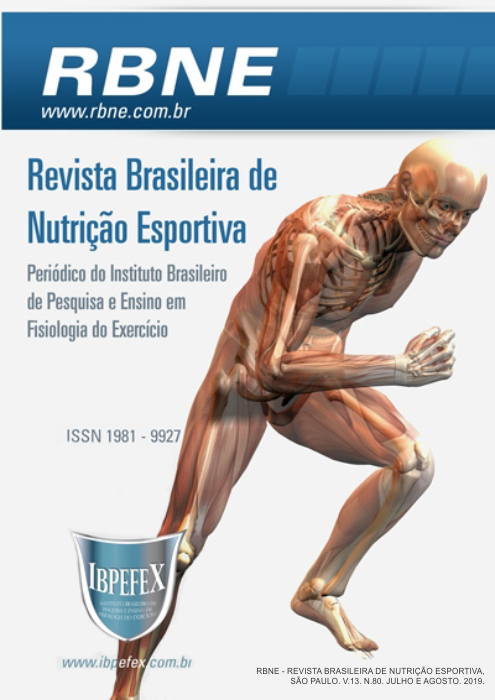Evaluation of the perception and satisfaction of the body image in women practicing musculation
Abstract
The perception of the body image is an aspect of great importance and that influences significantly in the well-being of the individual. The present study aimed to evaluate the perception of body image in women practicing bodybuilding and the relationship with their nutritional status. This study has a cross-sectional, descriptive character. The volunteers were randomly approached and invited to participate in the research, the data collection was done with the application of a questionnaire and anthropometric evaluation. A questionnaire with socioeconomic data and a tool for assessing body image perception was also applied. Body weight and height were also assessed for nutritional status by Body Mass Index (BMI). The research sample consisted of 135 women practicing bodybuilding and it can be observed that according to the BMI classification, the majority of women (64.4%) were classified as eutrophic. Only 10.37% stated they were satisfied with their current body image and 89.63% of the women stated they were dissatisfied with their current body, showing an interest in increasing their body weight, or in the majority of cases reducing their weight. Based on the data obtained in the study, it was possible to conclude that the majority of women attending the academies are dissatisfied with their body image.
References
-Almeida, A. R.; Athayde, F. T. S. Promoção da saúde, qualidade de vida e iniquidade em saúde: reflexões para a saúde pública. Tempus, actas de saúde coletiva. Vol.9. Num. 2. p. 2015. p. 165-172.
-Alves, E.; Calvo, M. C. M.; Neves, J.; Vasconcelos, F. A. G. Prevalência de sintomas de anorexia nervosa e insatisfação com a imagem corporal em adolescentes do sexo feminino do Município de Florianópolis, Santa Catarina, Brasil. Cadernos de Saúde Pública. Vol. 24. Núm. 3. 2008. p. 503-512.
-Bertolossi, E. H. W.; Sifuentes, R. R. O.; Gomes, L. C. S.; Navarro, A. C. Perfil de imagem corporal e exercício físico de pacientes com sobrepeso e obesidade de uma clínica de Nutrição de Brasília. Revista Brasileira de Obesidade, Nutrição e Emagrecimento. São Paulo. Vol. 2. Num. 9. 2008. p. 302-312. Disponível em: <http://www.rbone.com.br/index.php/rbone/article/view/91>
-Costa, L. C. F.; Vasconcelos, F. A. G. Influência de fatores socioeconômicos, comportamentais e nutricionais na insatisfação com a imagem corporal de universitárias em Florianópolis, SC. Revista Brasileira de Epidemiologia. São Paulo. Vol. 13. Num. 4. p. 2010. p. 665-676.
-Coqueiro, R. S.; Petroski, E. L.; Pelegrini, A.; Barbosa, A. R.; Insatisfação com a imagem corporal: avaliação comparativa da associação com estado nutricional em universitários. Rev Psiquiatr. Vol. 30. Num. 1. p. 31-168. 2008.
-Fermino, R. C.; Pezzini, M. R.; Reis, R. S. Motivos para prática de atividade física e imagem corporal em frequentadores de academia. Rev Bras Med Esporte. Vol. 16. Num. 1. 2010.
-Guimarães, I. C. T. Estado nutricional, avaliação de transtornos alimentares e autoimagem corporal em universitárias do rio de janeiro. Revista Brasileira de Obesidade, Nutrição e Emagrecimento. São Paulo. Vol. 12. Num. 70. 2018. p. 196-204. Disponível em: <http://www.rbone.com.br/index.php/rbone/article/view/677>
-Maleski, L. R.; Caparros D. R.; Viebig R. F. Estado nutricional, uso de suplementos alimentares e insatisfação corporal de frequentadores de uma academia. Revista Brasileira de Nutrição Esportiva. São Paulo. Vol. 10. Num. 59. 2016. p. 535-545. Disponível em: <http://www.rbne.com.br/index.php/rbne/article/view/685>
-Oliveira, L. L.; Hutz, C. S. Transtornos alimentares: o papel dos aspectos culturais no mundo contemporâneo. Psicologia em Estudo, Maringá, Vol. 15. Num. 3. 2010. p. 575-582.
-Organização Mundial de Saúde -OMS. Obesity: preventing and managing the global epidemic. Report of a WHO consultation, Geneva, 3-5 Jun 1997. Geneva: World Health Organization, 1998.
-Secchi, K.; Camargo, B. V.; Bertoldo, R. B. Percepção da imagem corporal e representações sociais do corpo. Psicologia: Teoria e Pesquisa. Vol. 25. Num. 2. 2009. p. 229-236.
-Silva, J. S.; Baratto, I. Análise da percepção, satisfação corporal e conhecimento nutricional entre mulheres praticantes de atividade física. Revista Brasileira de Nutrição Esportiva. São Paulo. Vol. 8. Num. 46. 2014. p. 238-246. Disponível em: <http://www.rbne.com.br/index.php/rbne/article/view/448>
-Silva G. R.; Terra G. D. S. V.; Tavares M. R.; Neiva C. M.; Bueno J. M.; Marinho C. F.; Forsan C. N.; Paiva M. A. Imagem corporal e estado nutricional de acadêmicas do curso de nutrição de universidade particular de alfenas. Revista Brasileira de Nutrição Esportiva. São Paulo. Vol. 10. Num. 56. p. 165-174. 2016. Disponível em: <http://www.rbne.com.br/index.php/rbne/article/view/619>
-Stunkard,A. J.; Sorensen,T.; Schlusinger, F. Use of the Danish Adoption Register for the study of obesity and thinness. In: Kety SS, Rowland LP, Sidman RL, Matthysse SW, editors. The genetics of neurological and psychiatric disorders. New York: Raven, 1983. p. 115-120.
-Vargas, C. S.; Moraes, C.B.; Mozzaquatro, N.F.; Kirsten, V.R. Prevalência de dismorfia muscular em mulheres frequentadoras de academia. Revista Brasileira de Nutrição Esportiva. São Paulo. Vol. 7. Num. 37. 2013. p. 28-34. Disponível em: <http://www.rbne.com.br/index.php/rbne/article/view/362>
Authors who publish in this journal agree to the following terms:
- Authors retain the copyright and grant the journal the right of first publication, with work simultaneously licensed under the Creative Commons Attribution License BY-NC which allows the sharing of the work with acknowledgment of the authorship of the work and initial publication in this journal.
- Authors are authorized to enter into additional contracts separately for non-exclusive distribution of the version of the work published in this journal (eg, publishing in institutional repository or book chapter), with acknowledgment of authorship and initial publication in this journal.
- Authors are allowed and encouraged to post and distribute their work online (eg, in institutional repositories or on their personal page) at any point before or during the editorial process, as this can bring about productive change as well as increase impact and impact. citation of published work (See The Effect of Free Access).






